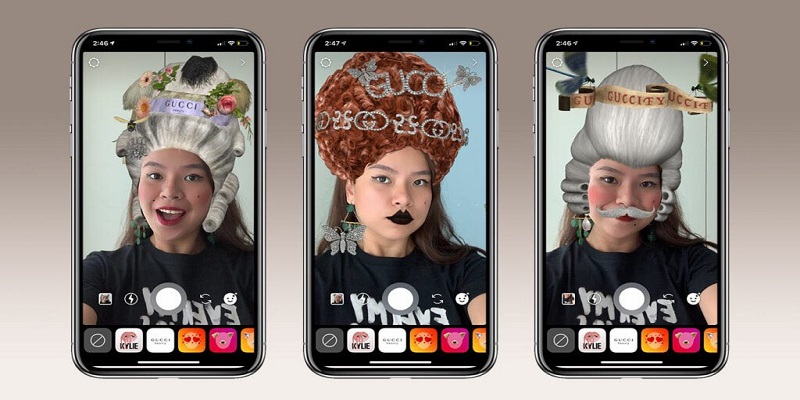
How many of you have tried Instagram and Snapchat filters? I guess everyone who uses a smartphone has tried it for once. These face filter features allow users to place various aesthetic or beautiful objects such as flowery crowns or digital makeups and more on their face. There are also cool interactive small games also which allow users to play the game and earn points against it. The banned app Tiktok also had such games. The technology behind these filters is artificial intelligence (AR) which is presently being used by ad agencies, live show event organisers, brands and more to give that extra shine to their audio visual content.
Graphixstory founder and CEO Surajit Majhi who is from the immersive technology industry shared with AnimationXpress, “Face filters by platforms like Instagram and Snapchat are very popular among young users. These features are now widely being accepted by various brands to promote their brand and set up a direct relationship with their users by creating branded filters and sharing the contents that their users are posting after using the same filter. One such example is, Cadbury Dairy Milk India which recently created an Instagram filter which allows the users to choose the language of their own choice to say ‘Thank You’ on the Cadbury Dairy Milk pack itself.”
According to Majhi, the beauty filters are encouraging users to create a lot of user generated contents which is going directly in favour of the respective brands as it is allowing them to amplify their reach in a great manner. “But Spark AR (the Facebook-owned AR effect/gaming creation platform) is relatively a young platform and we see a lot of scope of development within the platform itself and the best part is Spark AR is evolving rapidly with new features in regular intervals allowing the creators to create more interactive effects and games for the users. Whereas Lens Studio has a more complex architecture and scope of creation, using the platform is vast and robust. It also allows a creator to blend artificial intelligence and machine learning unlocking the scope of creating a more interactive and intuitive experience for the users. But both the platforms have their own set of limitations as well. This is where webAR platforms such as BlippAR, Unity and so on offer a creator more space to use the power of imagination and bring it to life by blending technology and creativity at its peak,” Majhi explained.
The use of AR across industries is yet to reach the peak. Various AR applications will continue to grow in 2021. According to global market advisory firm ABR Research, consumer AR software and content is expected to grow at over 100 per cent CAGR between 2021 and 2025, to reach US$20 billion in total revenue in 2025. The total AR Media and Entertainment market is expected to grow at 90 per cent. The ecommerce sector has been utilizing the technology for a while now and statistics show that people are more intent to buy furniture, clothes, makeup kits and jewelries using AR from any online store, which enables an user to test ‘try before you buy’ feature using the same app sitting at their favourite corner of their home. In the post pandemic world, AR will surely continue to transform the online shopping experience making it more convenient and trustable.
There are many such cases where brands are taking advantage of AR to address various problems in a very cost effective and convenient way. AR is playing the best role in blurring the line between the online and offline world. ‘At home discovery’ powered by AR is applicable across the sectors like: FMCG, automobile, gaming, home decor and so on. Today, because of AR, a user can see, test, evaluate and interact with a product sitting anywhere at their convenience. The best part is, the whole operation could be tracked by the marketers and they can collect more accurate data on user behaviour and impressions which will only improve user experience eventually. Majhi shared examples like:
–> LensKart is using AR 3D glasses on their website enabling their users or to be specific a potential buyer to try the glasses on their face to see the look and make a purchase decision before they buy.
–> eBay also has used a similar feature but this time from a seller’s perspective. While shipping a product, finding the right box can be a hassle. Ebay bought a clever solution using AR which allows a seller to select the best box for the respective product which needs to be shipped. The entire programme was built using Google’s AR Core platform on android devices leveraging the advantage of motion tracking and environmental understanding to place a real-world item inside a virtual box to find out the best fit.
Like any other industry, application of AR/XR in the field of animation, visual effects, gaming and comics is vast and the scope is huge. He shared that Marvel uses augmented reality to bring their comic book Avengers Vs X-Men to life. Arguably the most successful venture AR brought forward was its merging with animation. He expressed, “A device agnostic technology bringing forth the creative features of animation is almost blurring the lines of reality. Animation and AR now go hand in hand. An example where PepsiCo recently pranked the Londoners with an AR and animation enabled bus stop display. Travellers were shown a tiger growling, a meteor crashing and what not. This shows how vivid and real AR can come forward if put together with animation.”
Even live events like esports are also using these immersive technology for better visual experience. The League of Legends esport live world championship used XR (extended reality) experience for its audiences which was created by Riot Games, POSSIBLE, and Lux Machina. He explained, “The production relies on an ultra-advanced network environment and hardware system developed by Lux Machina that renders images in real time at a 32K resolution and 60 fps. Riot Games deployed more than 40 technicians and artists creating the one of the largest XR teams in the world while the broadcasts were co-produced and art directed by POSSIBLE. The screens integrated into the stage render at a whopping 32K resolution, and all the primary cameras are tracked so that data is mapped to the LED screens on stage. Apart from LEDs, Riot and POSSIBLE also used AR to create an extended 360 environment surrounding the stage. The 2020 League of Legends Esports World Championship is the first-ever live multi camera production using this technology.”
The scope of AR/XR is huge however, India is still in its early stages to adapt AR across industries but the growth is very promising. According to him, the pandemic has accelerated the growth and has opened the gate for AR creating a huge room for experiments and applications. Majhi concluded by saying, “The only challenge we have to overcome is the lack of necessary skill sets in our developers and also understanding of the pipeline of the creative process is also a barrier. A lot of R&D is still required.”


